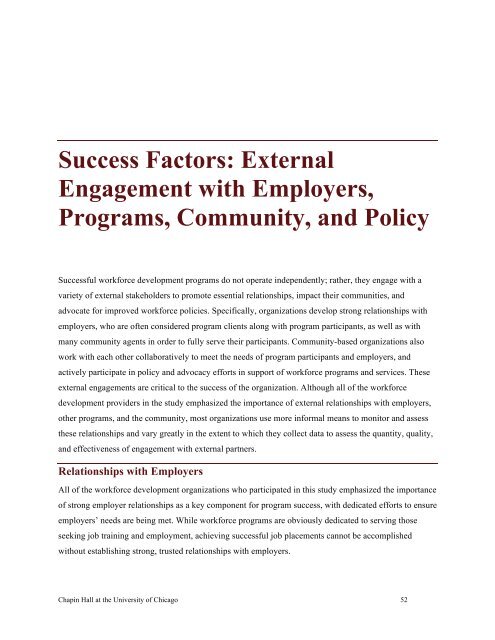Inside the Black Box - Chapin Hall at the University of Chicago
Inside the Black Box - Chapin Hall at the University of Chicago
Inside the Black Box - Chapin Hall at the University of Chicago
- No tags were found...
Create successful ePaper yourself
Turn your PDF publications into a flip-book with our unique Google optimized e-Paper software.
Success Factors: External<br />
Engagement with Employers,<br />
Programs, Community, and Policy<br />
Successful workforce development programs do not oper<strong>at</strong>e independently; ra<strong>the</strong>r, <strong>the</strong>y engage with a<br />
variety <strong>of</strong> external stakeholders to promote essential rel<strong>at</strong>ionships, impact <strong>the</strong>ir communities, and<br />
advoc<strong>at</strong>e for improved workforce policies. Specifically, organiz<strong>at</strong>ions develop strong rel<strong>at</strong>ionships with<br />
employers, who are <strong>of</strong>ten considered program clients along with program participants, as well as with<br />
many community agents in order to fully serve <strong>the</strong>ir participants. Community-based organiz<strong>at</strong>ions also<br />
work with each o<strong>the</strong>r collabor<strong>at</strong>ively to meet <strong>the</strong> needs <strong>of</strong> program participants and employers, and<br />
actively particip<strong>at</strong>e in policy and advocacy efforts in support <strong>of</strong> workforce programs and services. These<br />
external engagements are critical to <strong>the</strong> success <strong>of</strong> <strong>the</strong> organiz<strong>at</strong>ion. Although all <strong>of</strong> <strong>the</strong> workforce<br />
development providers in <strong>the</strong> study emphasized <strong>the</strong> importance <strong>of</strong> external rel<strong>at</strong>ionships with employers,<br />
o<strong>the</strong>r programs, and <strong>the</strong> community, most organiz<strong>at</strong>ions use more informal means to monitor and assess<br />
<strong>the</strong>se rel<strong>at</strong>ionships and vary gre<strong>at</strong>ly in <strong>the</strong> extent to which <strong>the</strong>y collect d<strong>at</strong>a to assess <strong>the</strong> quantity, quality,<br />
and effectiveness <strong>of</strong> engagement with external partners.<br />
Rel<strong>at</strong>ionships with Employers<br />
All <strong>of</strong> <strong>the</strong> workforce development organiz<strong>at</strong>ions who particip<strong>at</strong>ed in this study emphasized <strong>the</strong> importance<br />
<strong>of</strong> strong employer rel<strong>at</strong>ionships as a key component for program success, with dedic<strong>at</strong>ed efforts to ensure<br />
employers’ needs are being met. While workforce programs are obviously dedic<strong>at</strong>ed to serving those<br />
seeking job training and employment, achieving successful job placements cannot be accomplished<br />
without establishing strong, trusted rel<strong>at</strong>ionships with employers.<br />
<strong>Chapin</strong> <strong>Hall</strong> <strong>at</strong> <strong>the</strong> <strong>University</strong> <strong>of</strong> <strong>Chicago</strong> 52
















